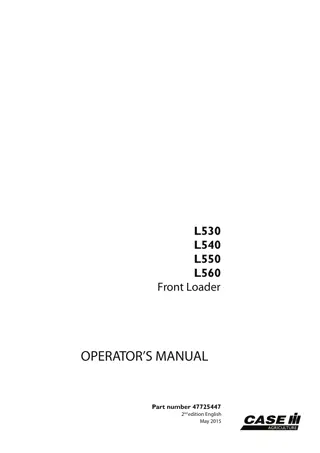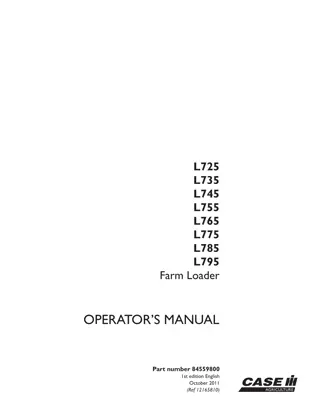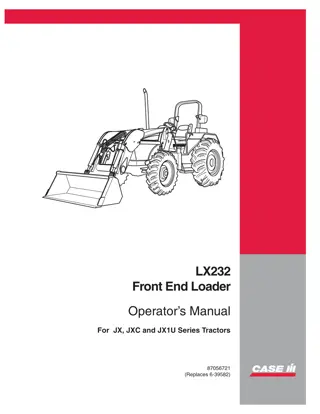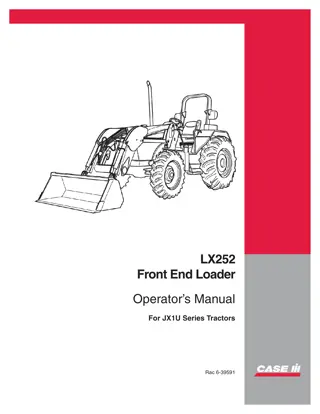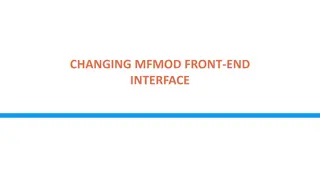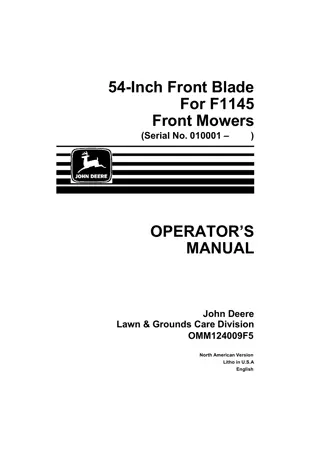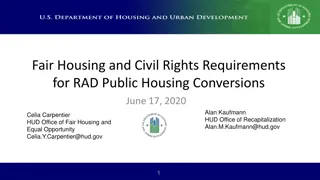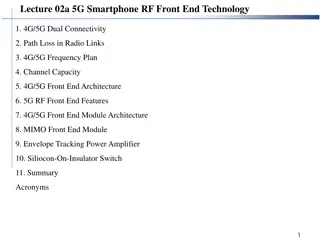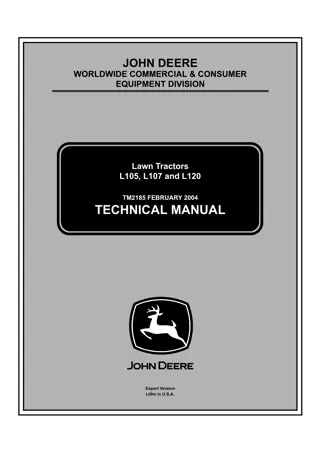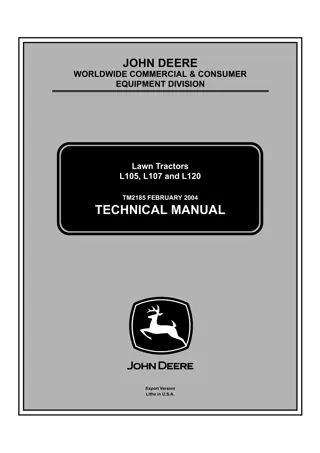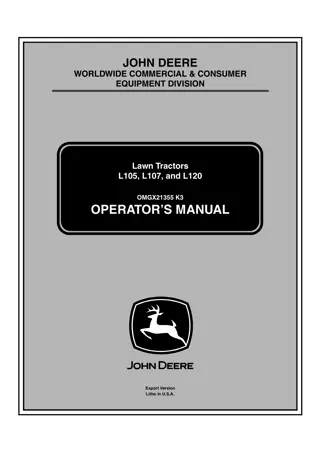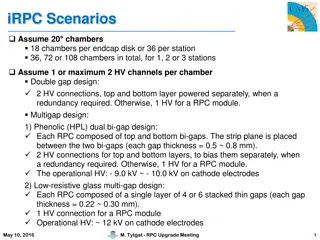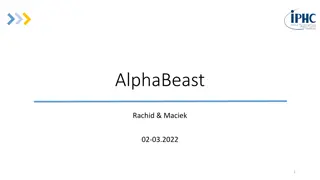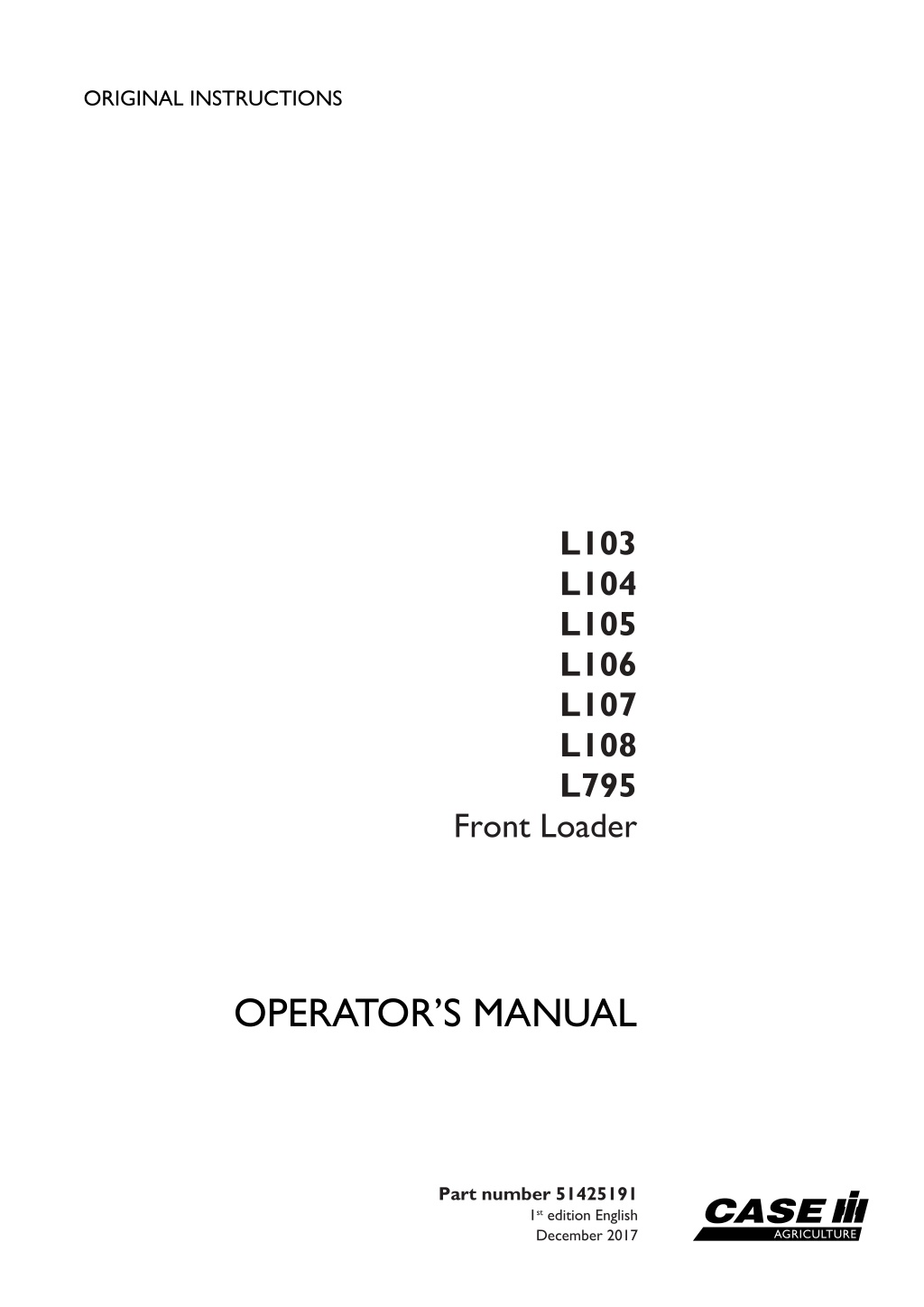
Case IH L103 L104 L105 L106 L107 L108 L795 Front Loader Operator’s Manual Instant Download (Publication No.51425191)
Please open the website below to get the complete manualnn//
Download Presentation

Please find below an Image/Link to download the presentation.
The content on the website is provided AS IS for your information and personal use only. It may not be sold, licensed, or shared on other websites without obtaining consent from the author. Download presentation by click this link. If you encounter any issues during the download, it is possible that the publisher has removed the file from their server.
E N D
Presentation Transcript
ORIGINAL INSTRUCTIONS L103 L104 L105 L106 L107 L108 L795 Front Loader OPERATOR S MANUAL Part number 51425191 1st edition English December 2017
Contents 1 GENERAL INFORMATION Note to the Owner .......................................................................... 1-1 Intended use................................................................................ 1-2 Electro-Magnetic Compatibility (EMC) ..................................................... 1-4 Machine orientation......................................................................... 1-5 Product identification ....................................................................... 1-6 Definition ................................................................................... 1-7 2 SAFETY INFORMATION Safety rules and signal word definitions.................................................... 2-1 Safety rules................................................................................. 2-2 Ecology and the environment .............................................................. 2-7 Safety signs ................................................................................ 2-8 3 OPERATING INSTRUCTIONS Commissioning the unit Machine preparation.................................................................... 3-1 Hydraulic controls ...................................................................... 3-4 Installing the loader..................................................................... 3-5 Removing the loader ................................................................... 3-7 Re-installing the loader................................................................. 3-9 Check list .............................................................................. 3-11 4 WORKING OPERATIONS General information Operating the loader.................................................................... 4-1 Soft-ride suspension-Optional.......................................................... 4-5 Remove bucket or attachment (SSL style) ............................................. 4-6 Install bucket or attachment (SSL style)................................................ 4-7 Remove bucket or attachment (EURO Style) .......................................... 4-9 Install bucket or attachment (EURO style) ............................................ 4-11 Remove bucket or attachment with hydraulic lock (EURO Style)-Optional ........... 4-13 Install bucket or attachment with hydraulic lock (EURO style)-Optional .............. 4-15 Operation with grapple fork attachment ............................................... 4-17 Operation with H.D. bale grip.......................................................... 4-19 Operation with bale spike attachment ................................................. 4-21 5 MAINTENANCE General information Note to the owner....................................................................... 5-1 Torque - Minimum tightening torques for normal assembly - Minimum Tightening Torques for Normal Assembly ................................................................... 5-2 Torque - Standard torque data for hydraulics - Standard torque data for hydraulics .. 5-5
Shut-off mechanism .................................................................... 5-7 Replacing the WEO plug-in coupling................................................... 5-8 Storage ................................................................................. 5-9 Consumables.......................................................................... 5-10 Maintenance planning Maintenance chart..................................................................... 5-11 Every 8 hours or daily Pivot points - Grease .................................................................. 5-11 After the first 10 hours Loader subframe torque-Check ....................................................... 5-13 Every 50 hours Loader subframe torque-Check ....................................................... 5-13 Check the hydraulic system for leaks ................................................. 5-14 6 TROUBLESHOOTING Symptom(s) Basic instructions............................................................... 6-1 Loader attachment - Troubleshooting .......................................... 6-1 7 SPECIFICATIONS Loader specifications....................................................................... 7-1 8 ACCESSORIES Loader attachments ........................................................................ 8-1 9 FORMS AND DECLARATIONS Predelivery report - Dealer copy............................................................ 9-1 Predelivery report - Owner copy ........................................................... 9-3
https://www.ebooklibonline.com Hello dear friend! Thank you very much for reading. Enter the link into your browser. The full manual is available for immediate download. https://www.ebooklibonline.com
1 - GENERAL INFORMATION 1 - GENERAL INFORMATION###_1_### Note to the Owner This manual contains information concerning the adjustment and maintenance of your new equipment. You have purchased a dependable machine, but only by proper care and operation can you expect to receive the performance and long service built into this equipment. Please have all operators read this manual carefully and keep it available for ready reference. Read and thoroughly understand this manual before operating this machine. If you are an inexperienced operator, study this manual and receive operating instructions from an experienced operator. Your dealer can assist you in learning machine operation and show you proper operating procedures. Keep this manual readily available, preferably with the machine. If the original manual is damaged, order a new one from your CASE IH dealer. Your CASE IH dealer will instruct you in the general operation of your new equipment. (Refer to the 'Delivery Report' at the back of this manual.) Your dealer's staff of factory-trained service technicians will be glad to answer any questions that may arise regarding the operation of your machine. Case IH Max Service is also available. Call 1-877-4CASEIH (1-877-422-7344) or email maxservice.na@cnh.com. Your CASE IH dealer carries a complete line of genuine CASE IH service parts. These parts are manufactured and carefully inspected to insure high quality and accurate fitting of any necessary replacement parts. Be prepared to give your dealer the model and product identification number of your new equipment when ordering parts. Locate these numbers now and record them below. Refer to the 'General Information' section of this manual for the location of the model and product identification numbers of your machine. PLEASE RECORD THE FOLLOWING INFORMATION Loader Model Product Identification Number (PIN) Date Purchased Attachment Model Attachment Model This is the safety alert symbol. It is used with and without signal words to alert you to potential personal injury hazards. Obey all safety messages that follow this symbol to avoid possible death or injury. WARNING Illustrations in this manual may show protective shielding open or removed to better illustrate a par- ticular feature or adjustment. Replace all shields before operating the machine. Failure to comply could result in death or serious injury. W0012A IMPROVEMENTS CNH Industrial America LLC is continually striving to improve its products. We reserve the right to make improvements or changes when it becomes practical and possible to do so, without incurring any obligation to make changes or additions to the equipment sold previously. 1-1
1 - GENERAL INFORMATION Intended use WARNING IMPROPER OPERATION OF THIS MACHINE CAN CAUSE DEATH OR SERIOUS INJURY. MAKE SURE THAT EVERY OPERATOR: -is instructed in the safe and proper use of this machine. -reads and understands the operator's manual for this machine. -reads and understands ALL safety signs on the machine. Failure to comply could result in death or serious injury. W0188A CAUTION Equipment failure could cause accident or injury! Never exceed the maximum safe working load of the loader. Failure to comply could result in minor or moderate injury. C0161A Your loader is designed and made to move material(s), dig, grade, and level, although within some physical limits. The working speed and performance may depend on a number of various parameters, such as weather and terrain conditions. Though the machine is designed to perform satisfactory in most materials and conditions, there may be a number of combinations of above parameters, for which there is severe degradation of performance of the machine. If you notice degradation of performance, contact your CASE IH dealer for assistance. He may have useful information for improvements, or a kit may be available to enhance the performance. The loader was designed to mount on CASE IH approved tractors. The loader is designed to load and move ma- terials with a variety of buckets and approved CASE IH attachments. Do not use the machine for another purpose than intended by the manufacturer and outlined in this manual. Do not use the machine beyond its limits of terrain gradient and stability as outlined further in this manual. Using the machine beyond these limits may result in roll-over or tip-over. Observe the recommendations in this manual. Use only approved accessories and attachments that are designed for your machine. Consult your dealer on changes, additions or modifications that may be required for your machine. Do not make any unauthorized modifi- cations to your machine. Do not use the machine near or on soft verges of canals and brooks or banks and verges that are undermined by rodents. The machine may sink sideways and roll-over. Do not use the machine on brittle bridge heads and poor bridge floors. These constructions may collapse and cause roll-over of the machine. Always check out the condition and carrying capacity of bridges and ramps prior to engage. Do not use the machine without wearing the seat restraint system during activities where roll-over or tip-over haz- ards exist. The Roll Over Protection Structure (ROPS) structure will only be fully effective when the driver remains attached to his seat. Do not use the machine beyond its limits of dynamic stability. High speed, abrupt maneuvers, and fast and short cornering will increase the risk of roll-over. Be cautious that the center of gravity of the machine may increase when loads on the bucket or attachment are raised. In these conditions, the machine may roll-over earlier than expected. You shall take the necessary precautions to always be aware of the possible presence of bystanders, certainly when maneuvering in confined areas, such as the farm yard and sheds. Keep people away from the machine during work; ask bystanders to leave the field. There is not only the risk to be overrun by the machine, but objects may be dropped from a loader. The path of the fallen objects are unknown. Keep bystanders away from the work area. Do not allow riders on the machine. All persons who will be operating this machine shall possess a valid local vehicle operating permit and/or other applicable local age work permits. The machine is designed and produced exclusively for agricultural use. The machine is not designed for light/heavy forestry applications; usage is prohibited for forestry applications. 1-2
1 - GENERAL INFORMATION All other use will be considered to be contrary to the use specified by CNH Industrial America LLC, who cannot be held liable for damage to property or the machine, or for personal injuries which may result. Persons who risk improper use will therefore assume the responsibility for any consequences arising from such use. Compliance with the instructions for use, maintenance and repairs described in this manual, are the essential pre- conditions for the use specified by CNH Industrial America LLC. The machine must only be used, serviced, or repaired by personnel trained in the relevant working methods and safety regulations and who have been authorized to work on the machine. The user must also observe the rules concerning general safety and accident prevention, including the Highway Code when driving on public highways. Any arbitrary modifications made to this machine will release CNH Industrial America LLC from any liability resulting from damage or injury. CNHIndustrialAmericaLLCandallitsdistributionorganizations, inclusiveof, butnotrestrictedto, national, regional, or local distributors, cannot be held liable for damage resulting from the malfunction of parts and/or components not approved by CNH Industrial America LLC. Under no circumstances will a guarantee be issued for products made or sold by CNH Industrial America LLC that are damaged as a result of the malfunction of parts and/or components not approved by CNH Industrial America LLC. 1-3
1 - GENERAL INFORMATION Electro-Magnetic Compatibility (EMC) Interference may arise as a result of add on equipment that may not necessarily meet the required standards. As such interference can result in serious malfunction of the unit and/or create unsafe situations, you must observe the following: The maximum power of emission equipment (radio, telephones, etc.) must not exceed the limits imposed by the national authorities of the country where you use the machine The electro magnetic field generated by the add on system should not exceed 24 V/m at any time and at any lo- cation in the proximity of electronic components The add on equipment must not interfere with the functioning of the on board electronics Failure to comply with these rules will render the CASE IH warranty null and void. 1-4
1 - GENERAL INFORMATION Machine orientation Alignment reference In this manual, references to right-hand and left-hand are consistently as seen from the operator s seat when facing forwards. NOTE: Some illustrations in this manual may show a different model of tractor or loader, compared with your loader. The same information applies to your equipment unless otherwise specified. 1 NHIL17GEN0052FA Right hand view 1-5
1 - GENERAL INFORMATION Product identification Product identification plate A product identification plate (1) is located on the inside of the left-hand loader arm. 1 20105780 The identification numbers on this plate are important in the event that your loader should require future service. The plate specifies: Model, Product Identification Number and Production Date. Theloadermodel, productidentificationnumber(PIN)and production date, must always be quoted during service questions or when spare parts are needed. 2 CIH SN PLATE 1-6
1 - GENERAL INFORMATION Definition Description 3rd function Optional hydraulic function for operating the attachment hydraulics. Bucket level indicator Device that indicates the angular position of the imple- ment during lifting and lowering movements. Control valve Valve designed for controlling the operation of the loader. Central control valve Central distribution valve, mounted on the loader cross tubewhichhasthecapabilitytoaccommodatehydraulic options. Quick Connect (Multi Coupler Fast Snap Style) Multi port hydraulic connection for coupling and uncou- pling the loader s hydraulics. Hose kit Hoses and hydraulic components for connecting the loader to the tractor's original remote valve. Soft-ride loader suspension Load damper, improves driver comfort and reduces stress on the tractor and loader when driving on rough surface SSL Quick Attach Attachments and loader attaching plate that is compat- ible with approved skid steer loader attachments. EURO Quick Attach Attachments with hooks and loader tool carrier con- nection system. Designed for international standard ISO23206. 1-7
2 - SAFETY INFORMATION 2 - SAFETY INFORMATION###_2_### Safety rules and signal word definitions Personal safety This is the safety alert symbol. It is used to alert you to potential personal injury hazards. Obey all safety messages that follow this symbol to avoid possible death or injury. Throughout this manual and on machine safety signs, you will find the signal words DANGER, WARNING, and CAU- TION followed by special instructions. These precautions are intended for the personal safety of you and those working with you. Read and understand all the safety messages in this manual before you operate or service the machine. DANGER indicates a hazardous situation that, if not avoided, will result in death or serious injury. The color associated with DANGER is RED. WARNING indicates a hazardous situation that, if not avoided, could result in death or serious injury. The color associated with WARNING is ORANGE. CAUTION indicates a hazardous situation that, if not avoided, could result in minor or moderate injury. The color associated with CAUTION is YELLOW. FAILURE TO FOLLOW DANGER, WARNING, AND CAUTION MESSAGES COULD RESULT IN DEATH OR SERIOUS INJURY. Machine safety NOTICE: Notice indicates a situation that, if not avoided, could result in machine damage or property damage. The color associated with Notice is BLUE. Throughout this manual you will find the signal word Notice followed by special instructions to prevent machine dam- age or property damage. The word Notice is used to address practices not related to personal safety. Information NOTE: Note indicates additional information that clarifies steps, procedures, or other information in this manual. Throughout this manual you will find the word Note followed by additional information about a step, procedure, or other information in the manual. The word Note is not intended to address personal safety or property damage. 2-1
2 - SAFETY INFORMATION Safety rules Apersonorpetwithintheoperatingareaofamachinecan be struck or crushed by the machine or its equipment. DO NOT allow anyone to enter the work area. General safety rules Use caution when you operate the machine on slopes. Raised equipment, full tanks and other loads will change the center of gravity of the machine. The machine can tip or roll over when near ditches and embankments or uneven surfaces. Raised equipment and/or loads can fall unexpectedly and crush persons underneath. Never allow anyone to enter the area underneath raised equipment during operation. Always Slow-Moving Vehicle (SMV) emblem clean to provide the best possible visibility while you operate the machine. keep windows, mirrors, all lighting, and Never permit anyone other than the operator to ride on the machine. Never operate the machine under the influence of alcohol or drugs, or while you are otherwise impaired. Operate controls only when seated in the operator s seat, except for those controls expressly intended for use from other locations. When digging or using ground-engaging attachments, be awareofburiedcables. Contactlocalutilitiestodetermine the locations of services. Before you leave the machine: 1. Park the machine on a firm, level surface. Pay attention to overhead power lines and hanging obsta- cles. High voltage lines may require significant clearance for safety. 2. Put all controls in neutral or park lock position. 3. Engage the parking brake. Use wheel chocks if re- quired. Hydraulic oil or diesel fuel leaking under pressure can penetrate the skin, causing serious injury or infection. 4. Lower all hydraulic equipment Implements, header, etc. DO NOT use your hand to check for leaks. Use a piece of cardboard or paper. 5. Turn off the engine and remove the key. Stop the engine, remove the key, and relieve the pres- sure before you connect or disconnect fluid lines. When, due to exceptional circumstances, you would decide to keep the engine running after you leave the operator s station, then you must follow these precautions: Make sure that all components are in good condition. Tighten all connections before you start the engine or pressurize the system. 1. Bring the engine to low idle speed. If hydraulic fluid or diesel fuel penetrates the skin, seek medical attention immediately. 2. Disengage all drive systems. WARNING Some components may continue to run down after you disengage drive systems. Make sure all drive systems are fully disen- gaged. Failure to comply could result in death or seri- ous injury. 3. Continuous long term contact with hydraulic fluid may cause skin cancer. Avoid long term contact and wash the skin promptly with soap and water. Keep clear of moving parts. watches, long hair, and other loose or hanging items can become entangled in moving parts. Loose clothing, jewelry, W0113A Wear protective equipment when appropriate. Shift the transmission into neutral. 4. Apply the parking brake. DO NOT attempt to remove material from any part of the machine while it is being operated or while components are in motion. General maintenance safety Make sure that all guards and shields are in good con- dition and properly installed before you operate the ma- chine. Never operate the machine with shields removed. Always close access doors or panels before you operate the machine. Keep the area used for servicing the machine clean and dry. Clean up spilled fluids. Service the machine on a firm, level surface. Install guards and shields after you service the machine. Dirty or slippery steps, ladders, walkways, and platforms can cause falls. Make sure these surfaces remain clean and clear of debris. Closeallaccessdoorsandinstallallpanelsafterservicing the machine. 2-2
2 - SAFETY INFORMATION Do not attempt to clean, lubricate, clear obstructions, or make adjustments to the machine while it is in motion or while the engine is running. Lift implements and attachments high enough above ground to prevent accidental contact with road. When you transport equipment or a machine on a trans- port trailer, make sure that it is properly secured. Be sure the SMV on the equipment or machine is covered while being transported on a trailer. Always make sure that working area is clear of tools, parts, other persons and pets before you start operating the machine. Unsupported hydraulic cylinders can lose pressure and drop the equipment, causing a crushing hazard. Do not leave equipment in a raised position while parked or dur- ing service, unless the equipment is securely supported. Be aware of overhead structures or power lines and make sure that the machine and/or attachments can pass safely under. Travel speed should be such that you maintain complete control and machine stability at all times. Jack or lift the machine only at jack or lift points indicated in this manual. Slow down and signal before turning. Incorrect towing procedures can cause accidents. When you tow a disabled machine follow the procedure in this manual. Use only rigid tow bars. Pull over to allow faster traffic to pass. Follow correct towing procedure for equipment with or without brakes. Stop the engine, remove the key, and relieve pressure before you connect or disconnect fluid lines. Fire and explosion prevention Stop the engine and remove the key before you connect or disconnect electrical connections. Fuel or oil that is leaked or spilled on hot surfaces or elec- trical components can cause a fire. Scalding can result from incorrect removal of coolant caps. Cooling systems operate under pressure. coolant can spray out if you remove a cap while the sys- tem is hot. Allow the system to cool before you remove the cap. When you remove the cap, turn it slowly to allow pressure to escape before you completely remove the cap. Hot Crop materials, trash, debris, bird nests, or flammable material can ignite on hot surfaces. Always have a fire extinguisher on or near the machine. Make sure that the fire extinguisher(s) is maintained and serviced according to the manufacturer s instructions. Replace damaged or worn tubes, hoses, electrical wiring, etc. At least once each day and at the end of the day, remove all trash and debris from the machine especially around hot components such as the engine, transmission, ex- haust, battery, etc. More frequent cleaning of your ma- chine may be necessary depending on the operating en- vironment and conditions. The engine, transmission, exhaust components, and hy- draulic lines may become hot during operation. Take care when you service such components. Allow surfaces to cool before you handle or disconnect hot components. Wear protective equipment when appropriate. At least once each day, remove debris accumulation around moving components such as bearings, pulleys, belts, gears, cleaning fans, etc. More frequent cleaning of your machine may be necessary depending on the operating environment and conditions. When welding, follow the instructions in the manual. Al- ways disconnect the battery before you weld on the ma- chine. Always wash your hands after you handle battery components. Inspect the electrical system for loose connections and frayed insulation. Repair or replace loose or damaged parts. Driving on public roads and general transportation safety Do not store oily rags or other flammable material on the machine. Comply with local laws and regulations. Use appropriate lighting to meet local regulations. Do not weld or flame cut any items that contain flammable material. Clean items thoroughly with non-flammable sol- vents before welding or flame-cutting. Make sure that the SMV emblem is visible. Make sure that the brake pedal latch is engaged. You must lock brake pedals together for road travel. Do not expose the machine to flames, burning brush, or explosives. Use safety chains for trailed equipment when safety chains are provided with machine or equipment. Promptly investigate any unusual smells or odors that may occur during operation of the machine. 2-3
2 - SAFETY INFORMATION authorities or utilities to obtain safe clearance distances from high voltage power lines. Personal Protective Equipment (PPE) Wear Personal Protective Equipment (PPE) such as hard hat, eyeprotection, heavygloves, hearingprotection, pro- tective clothing, etc. Retract raised or extended components, if necessary. Remove or lower radio antennas or other accessories. Should a contact between the machine and an electric power source occur, the following precautions must be taken: Do Not Operate tag Stop the machine movement immediately. Apply the parking brake, stop the engine, and remove the key. Before you start servicing the machine, attach a Do Not Operate warning tag to the machine in an area that will be visible. Check if you can safely leave the cab or your actual po- sition without contact with electrical wires. If not, stay in your position and call for help. If you can leave your position without touching lines, jump clear of the ma- chine to make sure that you do not make contact with the ground and the machine at the same time. Hazardous chemicals If you are exposed to or come in contact with hazardous chemicals you can be seriously injured. The fluids, lu- bricants, paints, adhesives, coolant, etc. required for the function of your machine can be hazardous. They may be attractive and harmful to domestic animals as well as humans. Do not permit anyone to touch the machine until power has been shut off to the power lines. Material Safety Data Sheets (MSDS) provide information about the chemical substances within a product, safe handling and storage procedures, first aid measures, and procedures to take in the event of a spill or accidental release. MSDS are available from your dealer. Electrical storm safety Do not operate machine during an electrical storm. If you are on the ground during an electrical storm, stay away from machinery and equipment. Seek shelter in a permanent, protected structure. Before you service your machine check the MSDS for each lubricant, fluid, etc. used in this machine. This in- formation indicates the associated risks and will help you service the machine safely. Follow the information in the MSDS, and on manufacturer containers, as well as the in- formation in this manual, when you service the machine. If an electrical storm should strike during operation, re- main in the cab. Do not leave the cab or operator s plat- form. Do not make contact with the ground or objects outside the machine. Dispose of all fluids, filters, and containers in an environ- mentally safe manner according to local laws and regula- tions. Check with local environmental and recycling cen- ters or your dealer for correct disposal information. Mounting and dismounting Mount and dismount the machine only at designated lo- cations that have handholds, steps, and/or or ladders. Store fluids and filters in accordance with local laws and regulations. Use only appropriate containers for the stor- age of chemicals or petrochemical substances. Do not jump off of the machine. Make sure that steps, ladders, and platforms remain clean and clear of debris and foreign substances. Injury may result from slippery surfaces. Keep out of reach or children or other unauthorized per- sons. Face the machine when you mount and dismount the ma- chine. Applied chemicals require additional precautions. Obtain complete information from the manufacturer or distributor of the chemicals before you use them. Maintain a three-point contact with steps, ladders, and handholds. Utility safety Never mount or dismount from a moving machine. When digging or using ground-engaging equipment, be aware of buried cables and other services. Contact your local utilities or authorities, as appropriate, to determine the locations of services. Do not use the steering wheel or other controls or acces- sories as handholds when you enter or exit the cab or operator s platform. Make sure that the machine has sufficient clearance to pass in all directions. Pay special attention to overhead power lines and hanging obstacles. High voltage lines may require significant clearance for safety. Contact local Working at heights When the normal use and maintenance of the machine requires you to work at heights: 2-4
2 - SAFETY INFORMATION Correctly use installed steps, ladders, and railings. Never use ladders, steps, or railings while the machine is moving. down, do not wear the seat belt. Always return the ROPS to the upright and locked position as soon as operating conditions permit. Do not stand on surfaces that are not designated as steps or platforms. Add the recommended wheel ballast and/or rear weight as recommended in the operator s manual to provide good stability. Do not use the machine as a lift, ladder, or platform for working at heights. Move the wheels to the tractor manufacturer's widest rec- ommended settings to increase stability. Lifting and overhead loads Move and turn the tractor at low speeds. Never use loader buckets, forks, etc. or other lifting, han- dling, or digging equipment to lift persons. Operating the loader Improper use of a loader can cause serious injury or death. Do not use raised equipment as a work platform. Knowthefullareaofmovementofthemachineandequip- ment and do not enter or permit anyone to enter the area of movement while the machine is in operation. Do not lift or carry anybody on the loader or in the bucket or attachment. Never allow anyone to get under the loader bucket or reach through the lift arms when the bucket is raised. Never enter or permit anyone to enter the area under- neath raised equipment. Equipment and/or loads can fall unexpectedly and crush persons underneath it. Do not walk or work under a raised loader, bucket, or at- tachment unless it is securely blocked or held in position. Do not leave equipment in raised position while parked or during service, unless securely supported. Hydraulic cylinders must be mechanically locked or supported if they are left in a raised position for service or access. Avoid overhead wires and obstacles when the loader is raised. Contacting electrical lines can cause electrocu- tion. Loader buckets, forks, etc. or other lifting, handling, or digging equipment and its load will change the center of gravity of the machine. This can cause the machine to tip on slopes or uneven ground. Make sure all dismounted loaders are on a hard, level surface. Do not repair, remove, or replace any parts of the loader while it is in the dismounted position. Load items can fall off the loader bucket or lifting equip- ment and crush the operator. Care must be taken when lifting a load. Use proper lifting equipment. It is the loader owner's responsibility to be certain that anyone operating the loader reads this manual first to be aware of the safe way of operating the loader. Do not lift load higher than necessary. Lower loads to transport. Remember to leave appropriate clearance to the ground and other obstacles. Exercise caution when operating the loader with a raised, loaded bucket or fork. Equipment and associated loads can block visibility and cause an accident. Do not operate with insufficient visi- bility. Avoid loose fill, rocks, and holes. They can be dangerous for loader operation or movement. Use care to maintain proper stability when operating on steep grades. Always carry the bucket in the lowest po- sition possible. Operating the tractor with the loader Use an approved roll bar and seat belt for safe operation. Overturning a tractor without a roll bar can result in death or injury. If your tractor is not equipped with a roll bar and seat belt, see your tractor dealer. Allow for the loader length when making turns. Stop the loader arms gradually when lowering or lifting. Use caution when handling loose or shiftable loads. Equip your tractor with FOPS (Falling Object Protective Structure) and seat belts before installing or operating the loader. Carry the bucket at a low position during transport for bet- ter visibility. Use the loader only on a tractor with the ROPS installed. Whenever possible, operate the tractor and loader with the ROPS in the upright and locked position and the seat belt fastened and correctly adjusted. When operating in restricted overhead environment with the ROPS folded When parking or servicing, lower the bucket to the ground, stop the engine, and set the parking brakes before leaving the tractor seat. 2-5
2 - SAFETY INFORMATION Operate the loader controls only when properly seated at the controls. Do not modify or alter, or permit anyone else to modify or alter, the loader or any of its components or any loader function without first consulting a CASE IH dealer. If you have any questions regarding loader modifications, con- tact your dealer. Using front end loaders without special attachments for handling large heavy objects such as large round or rectangular bales, logs, and oil drums is NOT RECOM- MENDED. Always wear safety goggles when servicing or repairing the machine. If you are handling large heavy objects, be sure to: Donottamperwiththereliefvalvesetting. Thereliefvalve is preset at the factory. Changing the setting can cause overloading the loader and tractor, and serious operator injury may result. use the proper attachment. only lift the load high enough to clear the ground when moving. properly ballast the tractor to compensate for the load. Always use shut off mechanism when servicing the ma- chine. See 5-7. Loader lift capacity and break-away capacity diminish as theloaderheightisincreased. Usecarenottograspmore material than the loader is designed to handle. Maintaining the loader When servicing or replacing the pins in the cylinder ends, bucket, etc., always use a drift and hammer. Failure to do so could result in injury from flying metal fragments. 2-6
2 - SAFETY INFORMATION Ecology and the environment Battery recycling Soil, air, and water quality is important for all industries and life in general. When legislation does not yet rule the treatment of some of the substances that advanced tech- nology requires, sound judgment should govern the use and disposal of products of a chemical and petrochemical nature. Batteries and electric accumulators contain several sub- stances that can have a harmful effect on the environ- ment if the batteries are not properly recycled after use. Improper disposal of batteries can contaminate the soil, groundwater, and waterways. CASE IH strongly recom- mends that you return all used batteries to a CASE IH dealer, who will dispose of the used batteries or recycle the used batteries properly. In some countries, this is a legal requirement. Familiarize yourself with the relative legislation applica- ble to your country, and make sure that you understand this legislation. Where no legislation exists, obtain in- formation from suppliers of oils, filters, batteries, fuels, anti-freeze, cleaning agents, etc., with regard to the ef- fect of these substances on man and nature and how to safely store, use, and dispose of these substances. Your CASE IH dealer can also provide assistance. Helpful hints Avoid the use of cans or other inappropriate pressur- ized fuel delivery systems to fill tanks. Such delivery systems may cause considerable spillage. In general, avoid skin contact with all fuels, oils, acids, solvents, etc. Most of these products contain sub- stances that may be harmful to your health. 1 NHIL14GEN0038AA Modern oils contain additives. Do not burn contami- nated fuels and or waste oils in ordinary heating sys- tems. Mandatory battery recycling NOTE: The following requirements are mandatory in Brazil. Avoid spillage when you drain fluids such as used en- gine coolant mixtures, engine oil, hydraulic fluid, brake fluid, etc. Do not mix drained brake fluids or fuels with lubricants. Store all drained fluids safely until you can dispose of the fluids in a proper way that complies with all local legislation and available resources. Batteries are made of lead plates and a sulfuric acid so- lution. Because batteries contain heavy metals such as lead, CONAMA Resolution 401/2008 requires you to re- turn all used batteries to the battery dealer when you re- place any batteries. Do not dispose of batteries in your household garbage. Do not allow coolant mixtures to get into the soil. Col- lect and dispose of coolant mixtures properly. Do not open the air-conditioning system yourself. It contains gases that should not be released into the atmosphere. Your CASE IH dealer or air-conditioning specialist has a special extractor for this purpose and can recharge the system properly. Points of sale are obliged to: Accept the return of your used batteries Store the returned batteries in a suitable location Send the returned batteries to the battery manufacturer for recycling Repair any leaks or defects in the engine cooling sys- tem or hydraulic system immediately. Do not increase the pressure in a pressurized circuit as this may lead to a component failure. 2-7
Suggest: If the above button click is invalid. Please download this document first, and then click the above link to download the complete manual. Thank you so much for reading
2 - SAFETY INFORMATION Safety signs The following safety signs are on your machine as a guide for your safety and for the safety of those working with you. Walk around the machine and note the content and the location of all safety signs before you operate your machine. Keep all safety signs clean and legible. Clean safety signs with a soft cloth, water, and gentle detergent. NOTICE: Do not use solvent, gasoline, or other harsh chemicals. Solvents, gasoline, and other harsh chemicals may damage or remove safety signs. Replace all safety signs that are damaged, missing, painted over, or illegible. If a safety sign is on a part you or your dealer replaces, make sure that you or your dealer install the safety sign on the new part. See your dealer for replacement safety signs. Replace all safety signs that are damaged, missing, painted over, or illegible. If a safety sign is on a part you or your dealer replaces, make sure that you or your dealer install the safety sign on the new part. See your dealer for replacement safety signs. Safety signs that display the Read operator s manual symbol direct you to the operator s manual for further information regarding maintenance, adjustments, or procedures for particular areas of the machine. When a safety sign displays this symbol, consult the appropriate page of the operator s manual. Safety signs that display the Read service manual symbol direct you to the service manual. If you doubt your ability to perform service operations, contact your dealer. 2-8
https://www.ebooklibonline.com Hello dear friend! Thank you very much for reading. Enter the link into your browser. The full manual is available for immediate download. https://www.ebooklibonline.com


